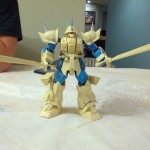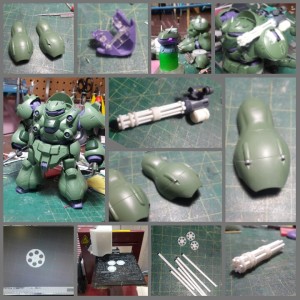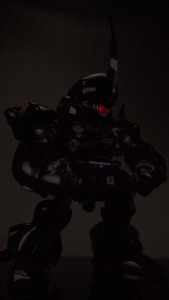So just shy of 3 weeks, this little quick and dirty project is done. I pulled some pictures from the previous posts showing the major miles stones starting with the simple snap fit, painted, flat coated, then weathered. It feels good to get a project done after so much time away from building. I normally try to document as much of the progress as possible so that others can learn, but sometime when I’m in the zone for building, I invariably forget about snapping a picture at certain moments, so if things are missed, or lost in translation, it should be fairly easy to assume from on progress picture to another. I’ve started to get better at writing the exact colors and brands I’m using. I find that sometimes, months or years goes by and I get a question on what color/brand I used for some kit and I have no idea, and go back to look at the progress page for that particular kit to see if it was written there or if it jogs my memory.
But enough of the babbling, the progress and some final pictures after the jump.
The weekends have been busy for me, a group of us hit up the opening day for the local Renaissance Faire, Yuki and I missed it last year, as we were knee deep in house renovations this time last year. Sunday we went to start packing up stuff from Yuki’s house as we’re getting ready to move everything out so that we can rent it out. But Sunday evening, I did get some time to spray some gloss over the kit.
The kit is first separated into major sub-assemblies, I really don’t see the need to paint each individual part separately, so by this point in the build, I’m mostly working with the major sub-assemblies. When I first started building, I would do everything separately, then do a final assembly at the end. I found that this caused more problems with fit and tonal differences in parts – so the more I build the more I tend to work with sub-assemblies. The parts are clear coated with Mr Super Clear Gloss. The gloss coat helps with decal adhesion. Decals stick much better to an ultra smooth and glossy surface. It reduces silvering and helps the decals look like they’re painted.
The last bits of progress requires the most time and patience. The end of the tunnel is visible, but it is here where the smallest mistakes cause the biggest headaches as little mistakes almost always require reworking a piece that has already taken weeks of work just to get to this point. So extra care and just slowing down to a crawl has helped minimize these instances. So the gloss is allowed to dry and cure for a day before starting on the decals. This reduces the chance that the decal softener solution reacts with the gloss. With a nice smooth, glossy surface, the decals that came with this kit are cut, dipped in water, and applied. These decals are precut water slides, so the decal application process went very smoothly. After the decals are placed on the parts, Mr Decal Softer is applied to the decals to soften the decal film and help the decal conform to the curves of the kit.
The decals as well as softening solution is left to cure overnight. Another clear gloss is sprayed to sandwich the decals. This protects the decals and helps balance any decal edges that are still visible. After about 3 hours of drying, a panel line wash using enamel paints thinned with rosonol lighter fluid. With a good gloss coat, the thinned wash solution easily runs along all the panel lines bringing out some decals in the kit. The excess wash is left on the kit for about an hour so that the wash solution has some time to dry. An hour after the wash solution application, a paper towel and q-tip dipped in some lighter fluid is used to clean up the excess ink spots. And with that done, the kit is almost there.
The next day, the wash solution has had several hours to dry. A clear flat is sprayed over everything to remove the glossy finish. After drying for a good 3 hours, the rest of the kit is assembled adding in some metal rivets that I picked up in Hong Kong. At this point, I could call the kit finished and snap completed pictures but I’ve been wanting to add a slight amount of weathering; just to show a bit of use as opposed to a fresh out of the factory look.
Finally, last night, the first step for the weathering was to add some paint chipping. I normally use an enamel based paint for the process, but decided to try the no. 2 pencil method that Dan from Funakatown.com uses. Some minor chipping is applied in sporadic areas just to show usage.
With the chipping done, the next step using tamiya weathering kits which is just the same as make up or chalk pastels. It is important to have a clear flat sprayed to the kit before doing this step. As with decals require a ultra smooth glossy surface for the best adhesion; pastel weathering requires a rough clear flat surface for the tiny pastel particle adhesion. Dust is applied to the feet, soot is applied to the Efreet’s arm mounted rocket launchers; and rust is applied at various spots. Once done, I applied another layer of clear flat to seal all the pastels to the surface of the kit. This final flat is optional, but to keep the pastels from rubbing off, the extra flat coat seals everything in and the kit can be handled fairly easily.
With that, the kit is done, below is the completed gallery:

|

|

|

|

|

|

|

|

|

|

|

|

|

|

|














Where did you get those resin parts?
This was a conversion kit from akohobby I believe. I originally got this kit from the website (unfortunately is no longer around). I did a quick search and couldn’t find the original sources. You may be able to find a recast of this kit from e2046, hobbyfan, or even gkmodel.